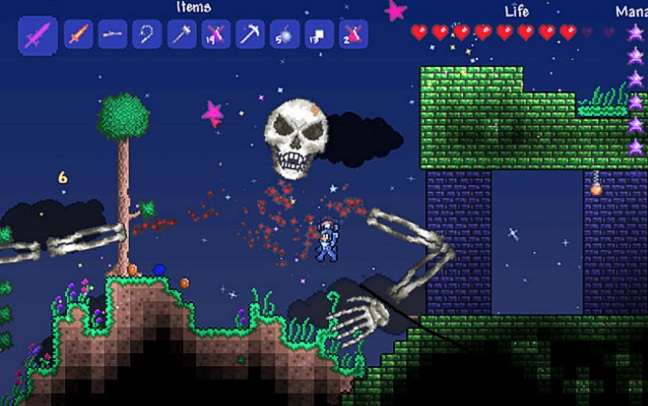Terraria focuses on collecting resources—both underground and above—and making a home to protect yourself and others from dangerous monsters that spawn at night. Although it is often compared to Minecraft, it plays more like a typical RPG, and there are many more goals and bosses to defeat to keep players of any kind occupied. As soon as you can figure out how to craft, build, and attract NPCs to your home, the game becomes addicting. The game did a good job of taking a used concept and improving upon it to stand on its own as a good game.
One of the commendable features of the game is that any character you create is not tied to a world. The two are created separately, so you can travel from one world to the next without losing your items. While this does open up a possibility for abuse (I found that whenever I needed wood, I could just switch to a new world, chop down some trees, and then return to my mining), the game almost expects you to do that, and made the difficulty curve very steep. You have to find lots of iron and enchanted items locked away underground if you even want to think about facing the many different bosses.
My favorite parts of playing through Terraria are the random events that occur with no prompt from the player. Falling stars, deadly meteorites, blood moons, and—if you wander far enough—random bosses all keep the game interesting and force you to structure your home properly. The huge library of items and upgrades found in dungeons and pots make character customization fun, even if you’re kind of forced into using the better armor.
The varied music at different times of day or deeper depths keep the soundtrack from getting boring—assuming most of your time is going into dungeon diving. The different layers are also an easy way to indicate difficulty, and the game is very good about increasing the difficulty of monsters as you gain more health and better armor. Many of the unique items in the game are refreshing additions to the platformer genre, such as equipment that increases your jumping ability, a grappling hook that allows fast travel through steep terrain, and speed boosts over flat terrain. While these aren’t individually unique, having all of them optionally available is a nice touch to the open-ended game, and allows players to customize their play style.
My main problem with the game is that once bosses are summoned, they do not leave the game or despawn. You have to deal with them until they die, and if it’s Eater of Worlds or Skeletron you’re dealing with, they’ll be able to follow you wherever you go. Skeletron in particular will automatically kill you at the end of every night. This is made worse by the fact Hardcore mode causes you to lose all of your items when you die. Another aggravating feature of the game is the actual mining. Mining vertically down takes a huge amount of time, and getting back out can be even more of a hassle if you haven’t acquired the grappling hook as a rare drop.
Overall, the first thirty minutes of the game are the toughest to get through, but once you have the basics figured out, it becomes addicting. Terraria adds plenty to the platformer genre and while it doesn’t have a typical plot, getting through to defeat the final bosses, explore the difficult areas, and collect rare treasures keeps the game interesting for several hours.


0 Comments